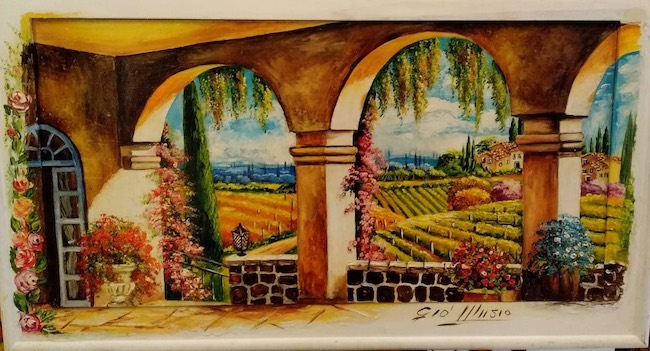L’espressività del mondo interiore di ciascun artista è in alcuni casi un modo per immergersi letteralmente in tutte le ansie, le paure e le destabilizzazioni che il singolo autore riceve dalla realtà, scegliendo così un approccio pittorico, sia esso figurativo o informale, in cui le gamme cromatiche e la raffigurazione siano affini a tutto il disagio che hanno bisogno di comunicare; in altri casi invece l’atto del dipingere può permettere all’autore di entrare in una dimensione idilliaca, trovando proprio nel gesto plastico la possibilità di astrarsi dalla contingenza tralasciando tutto ciò che nella quotidianità gli impedisce di trovare quella tranquillità che invece viene idealizzata nelle sue opere. L’artista di cui vi racconterò oggi raffigura un mondo armonioso, accogliente, semplice, esattamente come la sua tendenza naturale nei confronti di una vita che invece l’ha indotta a superare diverse difficoltà.
Il periodo storico che precedette gli stravolgimenti artistici del Ventesimo secolo, fu portatore di un’importante evoluzione nel modo di considerare e rappresentare la realtà da parte dei maggiori maestri dell’Ottocento, perché tutto ciò che ruotava intorno alla loro quotidianità, la natura e i luoghi frequentati, potevano essere narrati non solo mettendone in risalto la bellezza e la perfetta riproduzione bensì anche avvolgendo i dipinti con l’atmosfera respirata, con le sensazioni provate di fronte a panorami mozzafiato. Il Romanticismo Inglese fu il primo movimento a dare risalto alla natura prescindendo dalla figura umana, o solo inserendola come semplice comprimaria della maestosità del mondo che la accoglieva, nel caso delle atmosfere sublimi di William Turner, oppure narrandone la delicatezza e la poesia generata dalle sensazioni ricevute nel momento dell’osservazione di luoghi familiari eppure fonte di continua scoperta e ammirazione, nel caso di John Constable. Da quel momento in avanti si alternarono varie scuole di paesaggio sia in Italia, con la Scuola di Posillipo e i Macchiaioli, sia in Francia con la Scuola di Barbizon per finire agli Stati Uniti con la Hudson River School. Fu proprio quest’ultimo movimento artistico a subire più degli altri l’influenza del romanticismo mescolando l’attitudine all’emozionalità che permeava i dipinti romantici a un’osservazione realista con cui ritraevano non più soltanto la natura bensì anche gli insediamenti umani, in perfetto equilibrio tra scoperta ed esplorazione della meravigliosa bellezza del nuovo continente e al contempo la costruttività dell’uomo che erigeva edifici per creare comunità all’interno di quegli spazi incontaminati. Con la fine dell’Ottocento la pittura paesaggistica trovò una nuova evoluzione, quella della rappresentazione dei paesaggi urbani o delle zone industriali tipici del Precisionismo di Charles Sheeler della prima fase artistica di Georgia O’Keeffe, in cui emergeva una leggera influenza cubista, e dei sobborghi o delle atmosfere cittadine notturne che costituiscono un segno distintivo del Realismo Americano a cui appartiene la pittura di Edward Hopper, in cui il tratto realista è intriso di suggestione, di emozionalità nei confronti dei luoghi immortalati dove l’essere umano appare spesso solo, malinconico, piccolo dettaglio di un quadro generale, è proprio il caso di dirlo, in cui il frutto della sua creazione esercita un fascino irresistibile nell’autore quanto nell’osservatore. Nella contemporaneità gli artisti hanno ancor più la possibilità di unire le differenti esperienze pittoriche del passato per armonizzarle al proprio sentire, alla propria inclinazione inserendo contaminazioni provenienti da altre correnti che permettono loro di trovare il proprio linguaggio espressivo. Questo è il percorso compiuto dall’artista sarda Gioconda Musio, recentemente scomparsa, che ha dedicato la sua intera produzione pittorica proprio al paesaggio e alla natura morta, come se il contatto con il mondo che la ospitava fosse indispensabile per oltrepassare le difficoltà incontrate e superate fin da giovane, quando la sua scelta di vivere liberamente la sua creatività fu osteggiato da parenti e familiari perché l’epoca in cui era nata e vissuta era ancora fortemente legata alla credenza limitante che l’arte fosse una prerogativa prettamente maschile.
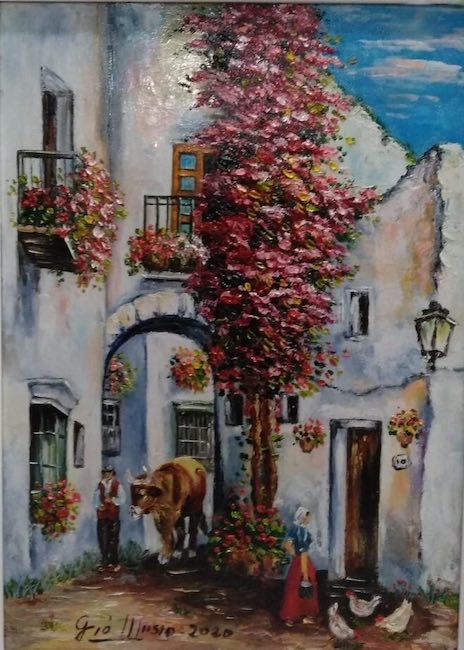
Nonostante la sofferenza che il distacco dagli affetti che in qualche modo le avevano imposto di compiere una scelta aveva provocato, Gioconda Musio non smise mai di combattere per realizzare il suo sogno, riuscendo a raggiungere incredibili risultati che le hanno permesso di esporre in molte città italiane e persino negli Stati Uniti.
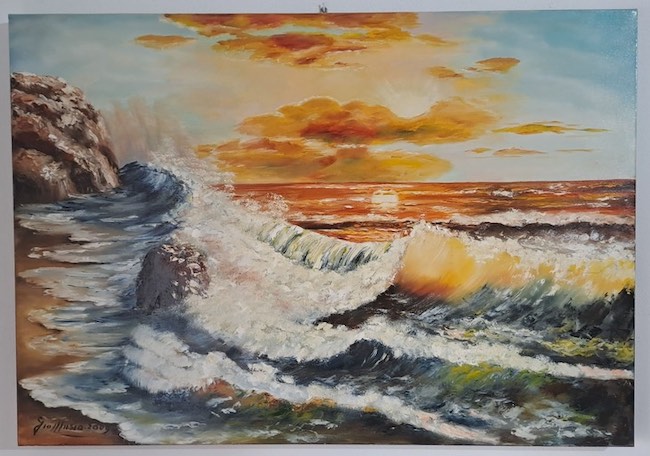
Ciò che colpisce delle opere dell’artista, in particolare quelle paesaggistiche, è il tratto realista mescolato a una gamma cromatica e a un’ambientazione a volte tendenti all’Espressionismo, altre verso un romantico Naif, attraverso cui lascia fuoriuscire le emozioni, le sensazioni che lei stessa riceveva nel momento in cui il suo sguardo si perdeva negli scorci che poi decideva di immortalare.
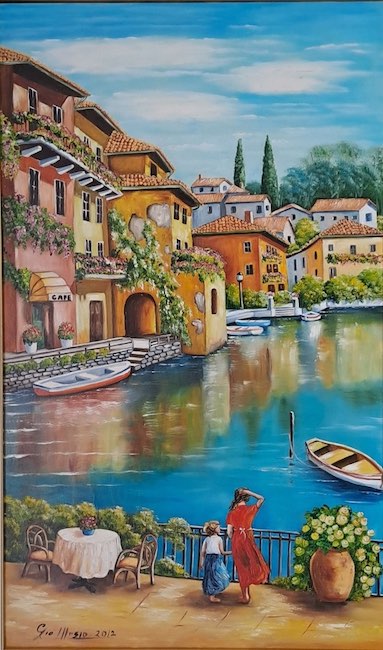
Innamorata della Toscana al punto di trasferirsi a Chianciano Terme, luogo scelto per aprire la sua galleria d’arte, Gioconda Musio ha dedicato molte tele proprio alla campagna intorno a sé, ai vicoli dei borghi che tanto amava visitare infondendo nei dipinti un’atmosfera quasi magica, frutto dello sguardo con cui sapeva interpretare il mondo circostante. La pittura era dunque per lei un’astrazione, un mezzo per dimenticare le difficoltà dell’esistenza indicando la possibilità di immergersi in un mondo reale, certo, ma che lascia spazio all’emozione, per spogliarsi da ogni negatività ed entrare nella dimensione della serenità, dell’equilibrio che riesce a manifestarsi solo nell’arte.
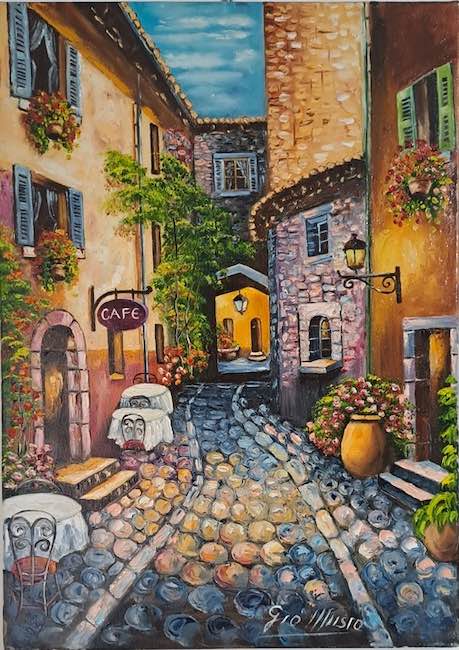
L’opera Antico borgo toscano rappresenta in pieno la tendenza espressiva di Gioconda Musio perché il vicolo descritto sembra ammantato da un’atmosfera fatata in virtù della scelta di ritrarlo al momento del crepuscolo, quando i tavoli ai lati della via sembrano in attesa di ospitare i clienti che lì trascorreranno la serata; la gamma cromatica è intensa e vivida dunque pur essendo affine alla realtà, sembra quasi spostarsi verso l’Espressionismo, quello più idilliaco e sognante vicino all’intento creativo di Marc Chagall, come a voler enfatizzare la sensazione piuttosto che l’osservazione. Il Realismo è mantenuto nella prospettiva, nei dettagli dei tavoli e dei muri delle case, ma l’Espressionismo si svela nella sovversione delle proporzioni dei ciottoli del selciato e nell’assenza delle sfumature del chiaroscuro tendendo a confondere lo sguardo che si trova accolto in una realtà parallela dove tutto può essere possibile.
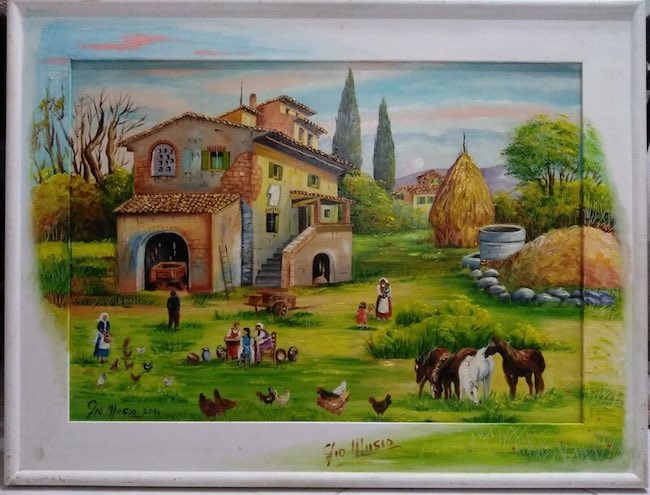
In Vecchia fattoria emerge l’attenzione di Gioconda Musio nei confronti del panorama che arrivava persino a mettere in secondo piano la presenza dell’uomo, in questo caso in perfetta armonia con la natura, con gli animali da cortile e i cavalli che rappresentano il mondo di quel microcosmo familiare immortalato dall’artista, evocando nell’osservatore il desiderio di perdersi all’interno di quella semplicità, allontanandosi per un attimo dalle difficoltà quotidiane di un mondo sempre più complesso, sempre più disumanizzante. E dunque il piccolo universo bucolico rappresentato in quest’opera ha bisogno di immediatezza espressiva, di dettagli precisi nella descrizione dell’edificio che accoglie l’intera comunità ma che poi perde le proporzioni nella descrizione delle persone, sottodimensionate rispetto alla casa, come se la Musio volesse sottolineare l’importanza della struttura nell’accogliere quel grande numero di persone rappresentato da una famiglia allargata e dagli animali, come volesse sottolinearne il calore. Oltre a questo anche le tonalità scelte avvicinano questa tela alla narrazione Naif, altra contaminazione presente nella pittura dell’artista.
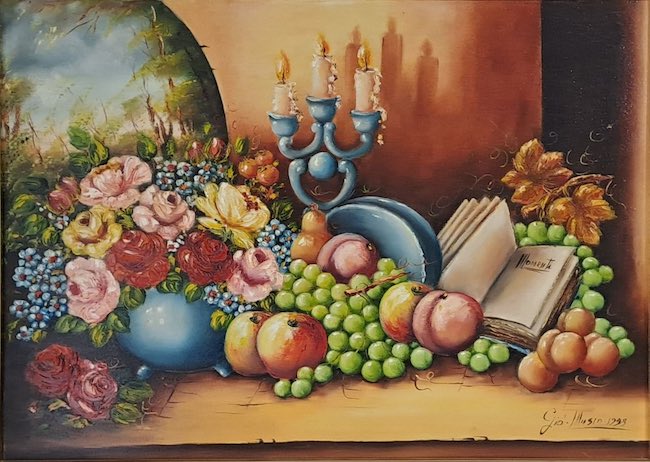
Un secondo importante ambito che contraddistingue la produzione di Gioconda Musio è quello delle nature morte, dove emerge in maniera dirompente il suo tratto realista svelato dalla capacità di particolareggiare ogni singolo elemento, ogni dettaglio delle composizioni, come se il loro essere presenti infondesse un senso di appartenenza, di calma familiarità ma anche di desiderio di sentirsi osservati e protagonisti di un momento in cui non sono più solo dei semplici oggetti.
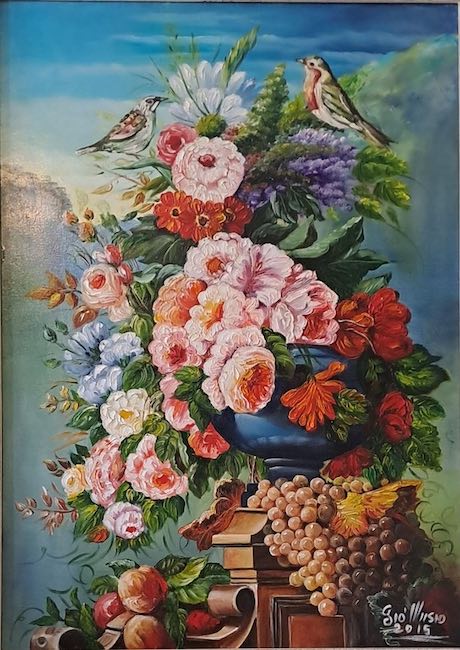
Ed è proprio questo che l’artista riesce a fare, mette in luce ciò che lo sguardo assuefatto non riesce più a vedere, dando la medesima rilevanza a ogni particolare, come nell’opera Composizione floreale con uccellini dove persino il vaso in cui sono contenuti i fiori pretende il suo spazio da protagonista. Gioconda Musio nel corso della sua carriera ha partecipato a numerose e importanti mostre collettive e personali su tutto il territorio italiano, tra cui una personale all’Accademia dell’Isola Tiberina nell’ambito delle cerimonie di inaugurazione dell’anno accademico del 1998, ha esposto anche a New York e Chicago in occasione di ArtExpo e le sue opere fanno parte di collezioni private di tutto il mondo.
GIOCONDA MUSIO-CONTATTI
Email: claudiocoro@hotmail.it
Facebook: https://www.facebook.com/gioconda.musio
Instagram: https://www.instagram.com/giocondamusio/
The serene and harmonious landscapes of Gioconda Musio’s Expressionist Realism, softly balanced between contingency and emotion
The expressiveness of each artist’s inner world is in some cases a way to literally immerse in all the anxieties, fears and destabilisations the individual author receives from reality, thus choosing a pictorial approach, be it figurative or informal, in which the colour ranges and depiction are akin to all the unease they need to communicate; in some cases, on the other hand, the act of painting can allow the author to enter an idyllic dimension, finding in the plastic gesture the possibility of abstracting himself from contingency, leaving aside everything that in everyday life prevents him from finding that tranquillity that is instead idealised in his artworks. The artist I am going to tell you about today depicts a harmonious, cosy, simple world, exactly like her natural tendency towards a life that instead led her to overcome various difficulties.
The historical period that preceded the artistic upheavals of the 20th century brought about an important evolution in the way the greatest masters of the 19th century considered and represented reality, because everything that revolved around their everyday life, nature and the places they frequented, could be narrated not only by emphasising their beauty and perfect reproduction, but also by enveloping the paintings with the atmosphere breathed in, with the sensations felt in front of breathtaking panoramas. English Romanticism was the first movement to give prominence to nature without the human figure, or only by inserting it as a simple companion to the majesty of the world that welcomed it, in the case of William Turner‘s sublime atmospheres, or by narrating the delicacy and poetry generated by the sensations received at the moment of observing familiar places yet a source of continuous discovery and admiration, in the case of John Constable. From then on, various schools of landscape painting alternated, both in Italy, with the Posillipo School and the Macchiaioli, in France with the Barbizon School, ending in the United States with the Hudson River School. It was the latter artistic movement that was influenced by Romanticism more than the others, mixing the attitude of emotionality that permeated Romantic paintings with a realist observation with which they no longer only portrayed nature but also human settlements, in a perfect balance between discovery and exploration of the marvellous beauty of the new continent and at the same time the constructiveness of man who erected buildings to create communities within those uncontaminated spaces. With the end of the 19th century, landscape painting found a new evolution, that of the depiction of urban landscapes or industrial areas typical of Charles Sheeler‘s Precisionism of Georgia O’Keeffe‘s first artistic phase, in which a slight cubist influence emerged, and of the suburbs or nocturnal city atmospheres that are a hallmark of American Realism to which Edward Hopper‘s painting belongs, in which the realist trait is imbued with suggestion, with emotionality towards the places immortalised where the human being often appears alone, melancholic, a small detail of a general picture, it must be said, in which the fruit of his creation exerts an irresistible fascination in the author as much as in the observer.
In the contemporary world, artists have even more of an opportunity to combine the different pictorial experiences of the past in order to harmonise them with their own feeling, their own inclination, inserting contaminations from other currents that allow them to find their own expressive language. This is the path followed by the Sardinian artist Gioconda Musio, recently passed away, who dedicated her entire painting production precisely to landscapes and still lifes, as if contact with the world in which she lived was indispensable for overcoming the difficulties she encountered and overcame from a young age, when her choice to live her creativity freely was opposed by relatives and parents because the era in which she was born and lived was still strongly tied to the limiting belief that art was a purely male prerogative. Despite the suffering that detachment from the affections that had somehow forced her to make a choice had caused, Gioconda Musio never stopped fighting to realise her dream, managing to achieve incredible results that allowed her to exhibit in many Italian cities and even in the United States. What strikes about the artist’s artworks, particularly the landscape ones, is the realistic trait mixed with a chromatic range and a setting sometimes tending towards Expressionism, others towards a romantic Naif, through which she lets out the emotions, the sensations that she herself received when her gaze was lost in the glimpses that she then decided to immortalise. In love with Tuscany to the point of moving to Chianciano Terme, the place she chose to open her art gallery, Gioconda Musio dedicated many canvases to the countryside around her, to the alleys of the villages she loved to visit so much, infusing her paintings with an almost magical atmosphere, the result of the gaze with which she knew how to interpret the world around her. For her, painting was therefore an abstraction, a means of forgetting the difficulties of existence by indicating the possibility of immersing oneself in a real world, certainly, but one that leaves room for emotion, to strip oneself of all negativity and enter into the dimension of serenity, of the balance that can only be manifested in art.
The artwork Ancient Tuscan Village fully represents Gioconda Musio‘s expressive tendency because the alley described seems to be cloaked in an enchanted atmosphere by virtue of her choice to portray it at twilight, when the tables on either side of the street seem to be waiting to accommodate the customers who will spend the evening there; the chromatic range is intense and vivid, so although it is close to reality, it almost seems to move towards Expressionism, the more idyllic and dreamy kind close to Marc Chagall‘s creative intent, as if to emphasise sensation rather than observation. Realism is maintained in the perspective, in the details of the tables and the walls of the houses, but Expressionism is revealed in the subversion of the proportions of the cobblestones of the pavement and in the absence of the nuances of chiaroscuro tending to confuse the eye, which finds itself welcomed into a parallel reality where anything can be possible. In Old farm emerges Gioconda Musio‘s attention to the landscape, even going so far as to overshadow the presence of man, in this case in perfect harmony with nature, with the farmyard animals and horses that represent the world of that familiar microcosm immortalised by the artist, evoking in the observer the desire to lose himself within that simplicity, distancing for a moment from the daily difficulties of an increasingly complex, increasingly dehumanising world. And so the small bucolic universe represented in this painting needs expressive immediacy, precise details in the description of the building that accommodates the entire community but then loses its proportions in the description of the people, undersized compared to the house, as if Musio wanted to emphasise the importance of the structure in accommodating that large number of people represented by an extended family and animals, as if to underline its warmth. In addition to this, the tones chosen also bring this canvas closer to the Naif narrative, another contamination present in the artist’s painting. A second important area that distinguishes Gioconda Musio‘s production is that of still lifes, where her realist trait emerges in a disruptive manner, revealed by her ability to detail every single element, every particular of the compositions, as if their being present instils a sense of belonging, of calm familiarity but also a desire to feel observed and protagonist of a moment in which they are no longer mere objects. And this is precisely what the artist succeeds in doing, she highlights what the addicted gaze can no longer see, giving equal importance to every detail, as in the painting Floral Composition with Birds where even the vase in which the flowers are contained claims its space as protagonist. In the course of her career, Gioconda Musio has taken part in numerous important group and solo exhibitions throughout Italy, including a personal exhibition at the Accademia dell’Isola Tiberina as part of the opening ceremonies of the academic year 1998. She has also exhibited in New York and Chicago on the occasion of ArtExpo, and her paintings are part of private collections all over the world.


